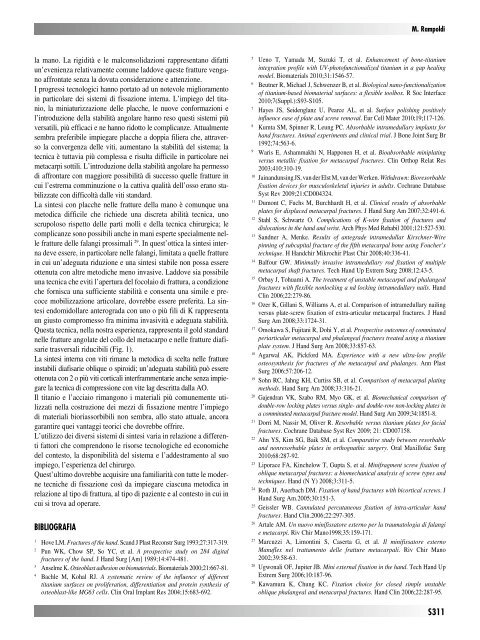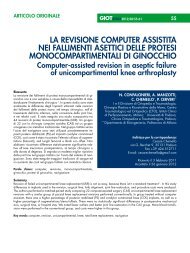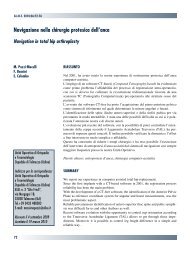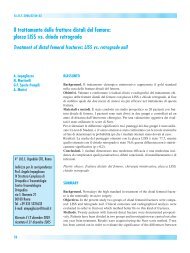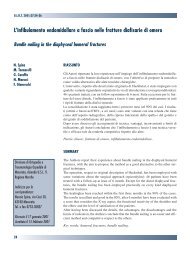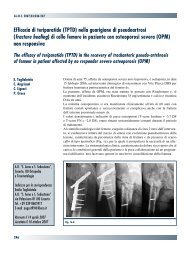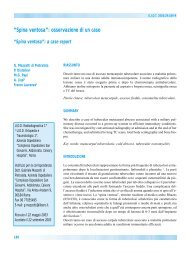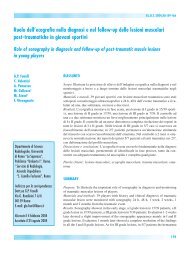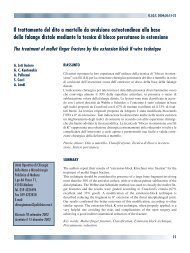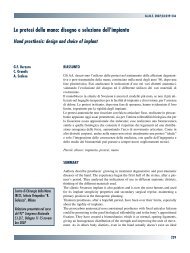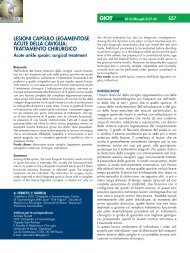30845 Suppl Giot.pdf - Giornale Italiano di Ortopedia e Traumatologia
30845 Suppl Giot.pdf - Giornale Italiano di Ortopedia e Traumatologia
30845 Suppl Giot.pdf - Giornale Italiano di Ortopedia e Traumatologia
You also want an ePaper? Increase the reach of your titles
YUMPU automatically turns print PDFs into web optimized ePapers that Google loves.
la mano. La rigi<strong>di</strong>tà e le malconsolidazioni rappresentano <strong>di</strong>fatti<br />
un’evenienza relativamente comune laddove queste fratture vengano<br />
affrontate senza la dovuta considerazione e attenzione.<br />
I progressi tecnologici hanno portato ad un notevole miglioramento<br />
in particolare dei sistemi <strong>di</strong> fissazione interna. L’impiego del titanio,<br />
la miniaturizzazione delle placche, le nuove conformazioni e<br />
l’introduzione della stabilità angolare hanno reso questi sistemi più<br />
versatili, più efficaci e ne hanno ridotto le complicanze. Attualmente<br />
sembra preferibile impiegare placche a doppia filiera che, attraverso<br />
la convergenza delle viti, aumentano la stabilità del sistema; la<br />
tecnica è tuttavia più complessa e risulta <strong>di</strong>fficile in particolare nei<br />
metacarpi sottili. L’introduzione della stabilità angolare ha permesso<br />
<strong>di</strong> affrontare con maggiore possibilità <strong>di</strong> successo quelle fratture in<br />
cui l’estrema comminuzione o la cattiva qualità dell’osso erano stabilizzate<br />
con <strong>di</strong>fficoltà dalle viti standard.<br />
La sintesi con placche nelle fratture della mano è comunque una<br />
meto<strong>di</strong>ca <strong>di</strong>fficile che richiede una <strong>di</strong>screta abilità tecnica, uno<br />
scrupoloso rispetto delle parti molli e della tecnica chirurgica; le<br />
complicanze sono possibili anche in mani esperte specialmente nelle<br />
fratture delle falangi prossimali 29 . In quest’ottica la sintesi interna<br />
deve essere, in particolare nelle falangi, limitata a quelle fratture<br />
in cui un’adeguata riduzione e una sintesi stabile non possa essere<br />
ottenuta con altre meto<strong>di</strong>che meno invasive. Laddove sia possibile<br />
una tecnica che eviti l’apertura del focolaio <strong>di</strong> frattura, a con<strong>di</strong>zione<br />
che fornisca una sufficiente stabilità e consenta una simile e precoce<br />
mobilizzazione articolare, dovrebbe essere preferita. La sintesi<br />
endomidollare anterograda con uno o più fili <strong>di</strong> K rappresenta<br />
un giusto compromesso fra minima invasività e adeguata stabilità.<br />
Questa tecnica, nella nostra esperienza, rappresenta il gold standard<br />
nelle fratture angolate del collo del metacarpo e nelle fratture <strong>di</strong>afisarie<br />
trasversali riducibili (Fig. 1).<br />
La sintesi interna con viti rimane la meto<strong>di</strong>ca <strong>di</strong> scelta nelle fratture<br />
instabili <strong>di</strong>afisarie oblique o spiroi<strong>di</strong>; un’adeguata stabilità può essere<br />
ottenuta con 2 o più viti corticali interframmentarie anche senza impiegare<br />
la tecnica <strong>di</strong> compressione con vite lag descritta dalla AO.<br />
Il titanio e l’acciaio rimangono i materiali più comunemente utilizzati<br />
nella costruzione dei mezzi <strong>di</strong> fissazione mentre l’impiego<br />
<strong>di</strong> materiali bioriassorbibili non sembra, allo stato attuale, ancora<br />
garantire quei vantaggi teorici che dovrebbe offrire.<br />
L’utilizzo dei <strong>di</strong>versi sistemi <strong>di</strong> sintesi varia in relazione a <strong>di</strong>fferenti<br />
fattori che comprendono le risorse tecnologiche ed economiche<br />
del contesto, la <strong>di</strong>sponibilità del sistema e l’addestramento al suo<br />
impiego, l’esperienza del chirurgo.<br />
Quest’ultimo dovrebbe acquisire una familiarità con tutte le moderne<br />
tecniche <strong>di</strong> fissazione così da impiegare ciascuna meto<strong>di</strong>ca in<br />
relazione al tipo <strong>di</strong> frattura, al tipo <strong>di</strong> paziente e al contesto in cui in<br />
cui si trova ad operare.<br />
BIBLIOGraFIa<br />
1 Hove LM. Fractures of the hand. Scand J Plast Reconstr Surg 1993;27:317-319.<br />
2 Pun WK, Chow SP, So YC, et al. A prospective study on 284 <strong>di</strong>gital<br />
fractures of the hand. J Hand Surg [Am] 1989;14:474-481.<br />
3 Anselme K. Osteoblast adhesion on biomaterials. Biomaterials 2000;21:667-81.<br />
4 Bachle M, Kohal RJ. A systematic review of the influence of <strong>di</strong>fferent<br />
titanium surfaces on proliferation, <strong>di</strong>fferentiation and protein synthesis of<br />
osteoblast-like MG63 cells. Clin Oral Implant Res 2004;15:683-692.<br />
M. rampol<strong>di</strong><br />
5 Ueno T, Yamada M, Suzuki T, et al. Enhancement of bone-titanium<br />
integration profile with UV-photofunctionalized titanium in a gap healing<br />
model. Biomaterials 2010;31:1546-57.<br />
6 Beutner R, Michael J, Schwenzer B, et al. Biological nano-functionalization<br />
of titanium-based biomaterial surfaces: a flexible toolbox. R Soc Interface<br />
2010;7(<strong>Suppl</strong>.):S93-S105.<br />
7 Hayes JS, Seidenglanz U, Pearce AL, et al. Surface polishing positively<br />
influence ease of plate and screw removal. Eur Cell Mater 2010;19;117-126.<br />
8 Kumta SM, Spinner R, Leung PC. Absorbable intramedullary implants for<br />
hand fractures. Animal experiments and clinical trial. J Bone Joint Surg Br<br />
1992;74:563-6.<br />
9 Waris E, Ashammakhi N, Happonen H, et al. Bioabsorbable miniplating<br />
versus metallic fixation for metacarpal fractures. Clin Orthop Relat Res<br />
2003;410:310-19.<br />
10 Jainandunsing JS, van der Elst M, van der Werken. Withdrawn: Bioresorbable<br />
fixation devices for musculoskeletal injuries in adults. Cochrane Database<br />
Syst Rev 2009;21:CD004324.<br />
11 Dumont C, Fuchs M, Burchhardt H, et al. Clinical results of absorbable<br />
plates for <strong>di</strong>splaced metacarpal fractures. J Hand Surg Am 2007;32:491-6.<br />
12 Stahl S, Schwartz O. Complications of K-wire fixation of fractures and<br />
<strong>di</strong>slocations in the hand and wrist. Arch Phys Med Rehabil 2001;121:527-530.<br />
13 Sandner A, Menke. Results of antegrade intramedullar Kirschner-Wire<br />
pinning of subcapital fracture of the fifth metacarpal bone using Foucher’s<br />
technique. H Handchir Mikrochir Plast Chir 2008;40:336-41.<br />
14 Balfour GW. Minimally invasive intramedullary rod fixation of multiple<br />
metacarpal shaft fractures. Tech Hand Up Extrem Surg 2008;12:43-5.<br />
15 Orbay J, Tohuami A. The treatment of unstable metacarpal and phalangeal<br />
fractures with flexible nonlocking a nd locking intramedullary nails. Hand<br />
Clin 2006;22:279-86.<br />
16 Ozer K, Gillani S, Williams A, et al. Comparison of intramedullary nailing<br />
versus plate-screw fixation of extra-articular metacarpal fractures. J Hand<br />
Surg Am 2008;33:1724-31.<br />
17 Omokawa S, Fujitani R, Dohi Y, et al. Prospective outcomes of comminuted<br />
periarticular metacarpal and phalangeal fractures treated using a titanium<br />
plate system. J Hand Surg Am 2008;33:857-63.<br />
18 Agarwal AK, Pickford MA. Experience with a new ultra-low profile<br />
osteosynthesis for fractures of the metacarpal and phalanges. Ann Plast<br />
Surg 2006;57:206-12.<br />
19 Sohn RC, Jahng KH, Curtiss SB, et al. Comparison of metacarpal plating<br />
methods. Hand Surg Am 2008;33:316-21.<br />
20 Gajendran VK, Szabo RM, Myo GK, et al. Biomechanical comparison of<br />
double-row locking plates versus single- and double-row non-locking plates in<br />
a comminuted metacarpal fracture model. Hand Surg Am 2009;34:1851-8.<br />
21 Dorri M, Nassir M, Oliver R. Resorbable versus titanium plates for facial<br />
fractures. Cochrane Database Syst Rev 2009; 21: CD007158.<br />
22 Ahn YS, Kim SG, Baik SM, et al. Comparative study between resorbable<br />
and nonresorbable plates in orthognathic surgery. Oral Maxillofac Surg<br />
2010;68:287-92.<br />
23 Liporace FA, Kinchelow T, Gupta S, et al. Minifragment screw fixation of<br />
oblique metacarpal fractures: a biomechanical analysis of screw types and<br />
techniques. Hand (N Y) 2008;3:311-5.<br />
24 Roth JJ, Auerbach DM. Fixation of hand fractures with bicortical screws. J<br />
Hand Surg Am.2005;30:151-3.<br />
25 Geissler WB. Cannulated percutaneous fixation of intra-articular hand<br />
fractures. Hand Clin.2006;22:297-305.<br />
26 Artale AM. Un nuovo minifissatore esterno per la traumatologia <strong>di</strong> falangi<br />
e metacarpi. Riv Chir Mano1998;35:159-171.<br />
27 Marcuzzi A, Limontini S, Caserta G, et al. Il minifissatore esterno<br />
Manuflex nel trattamento delle fratture metacarpali. Riv Chir Mano<br />
2002;39:58-63.<br />
28 Ugwonali OF, Jupiter JB. Mini external fixation in the hand. Tech Hand Up<br />
Extrem Surg 2006;10:187-96.<br />
29 Kawamura K, Chung KC. Fixation choice for closed simple unstable<br />
oblique phalangeal and metacarpal fractures. Hand Clin 2006;22:287-95.<br />
S311


